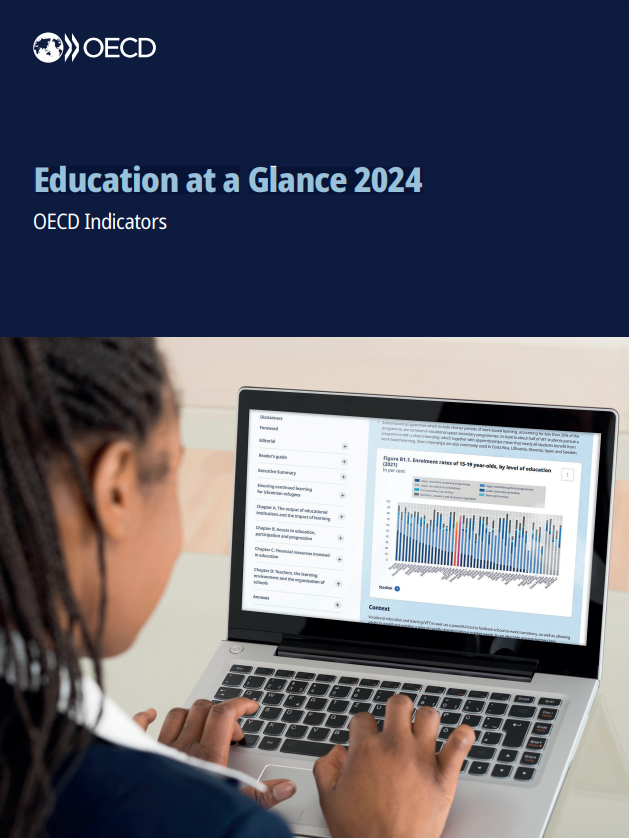- 매년 OECD 교육기술국이 회원 38개국과 일부 비회원국의 교육 재정과 현황을 분석해 내놓는 이 보고서는 교육 전반에 관한 권위 있는 국제 비교 기초 자료로 주목받음
□ 2023년 한국의 만 25~64세 성인 고등교육(대학) 이수율(대졸 이상)은 54.5%로 평균(40.7%) 이상이며, 청년인 만 25~34세의 경우 69.7%로 OECD 중 1위이나, 고용률은 OECD 국가 평균 수준을 밑도는 것으로 나타남
- 2023년 우리나라 만 25~64세 성인 교육단계별 고용률은 고졸 72.5%, 전문대졸 78.2%, 대졸은 79.7%였으나, OECD 평균은 고졸 76.9%, 전문대졸 81.9%, 대졸 86.0%로 모두 한국 수준보다 높았음
- 비경제활동인구 비율도 한국은 세계적으로 높은 수준임
□ 2023년 한국 국·공립학교 초임교사의 법정 급여는 3만 6639달러(약 4929만원)였으며, 이는 OECD 평균인 4만 2060달러(약 5657만원)보다 12% 낮은 금액임
📌 OECD 교육지표 2024 주요 내용

[출처]
[보도자료] 경제협력개발기구(OECD) 교육지표 2024 결과 발표 (2024.09.10.) / 교육부
대졸 청년 OECD 1위 한국…'노는 대졸 청년' 비율도 최상위권 (2024.09.10.) / 뉴시스
교사 급여 초임 때만 낮다? OECD 분석 보니 (2024.09.10.) / 경향신문
목차
Foreword 3
Editorial 6
Reader's guide 8
Executive summary 19
SDG. Equity in the education sustainable development goal 22
Part A. The output of educational institutions and the impact of learning 42
Chapter A1. To what level have adults studied? 43
Chapter A2. Transition from education to work: where are today's youth? 64
Chapter A3. How does educational attainment affect participation in the labour market? 78
Chapter A4. What are the earnings advantages to education? 97
Chapter A5. To what extent do adults participate in education and training? 121
Chapter A6. How are social outcomes related to education? 135
Part B. Access to education, participation and progression 153
Chapter B1. How does participation in early childhood education and care differ among countries? 154
Chapter B2. What are the main characteristics of primary and lower secondary education? 182
Chapter B3. What are the key features of general and vocational upper secondary education? 204
Chapter B4. What are the differences in access and outcomes of tertiary education? 228
Part C. Financial resources invested in education 248
Introduction 249
Chapter C1. How much is spent per student on educational institutions? 252
Chapter C2. What proportion of national output is spent on educational institutions? 272
Chapter C3. How much public and private investment in educational institutions is there? 285
Chapter C4. What is the total government spending on education? 302
Chapter C5. How much do tertiary students pay and what public support do they receive? 316
Chapter C6. On what resources and services is education funding spent? 336
Part D. Teachers, the learning environment and the organisation of school 349
Chapter D2. What is the student-teacher ratio and how large are classes and schools? 350
Chapter D3. How much are teachers and school heads paid? 374
Chapter D4. How much time do teachers spend teaching and working? 399
Chapter D5. Who are the teachers, and where do countries stand in terms of teacher shortages? 418
Chapter D6. How are the views of parents and students formally represented in the education system? 444
Annexes 461
Annex 1. Characteristics of education systems 462
Annex 2. Reference statistics 470
해시태그
관련자료
AI 100자 요약·번역서비스
인공지능이 자동으로 요약·번역한 내용입니다.




